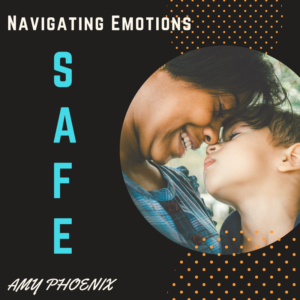guest post by Amy Phoenix

Navigating emotions can be one of the most tumultuous experiences parents get to deal with. When my first child hit the toddler years it became really clear that I needed to address my own emotions before I could help her with hers. Over time I came up with a little practice I call SAFE. (It’s helpful to practice this when you are not feeling intense emotions so you have a base to work from).
S is for Stop and Notice. When feeling strong emotion, stop outwardly acting on the feeling (talking/touching/grabbing/spanking/yelling/whatever) and notice what is going on in your mind and body. If you feel inclined to touch someone forcefully, bring your hands (and/or feet) close to your own body. What thoughts are present? How does your body feel? Where in your body do you feel what you feel? Notice your breath and bring your attention deeply into your breath as you gradually feel the inside of your body from head to toe.
A is for Acknowledge and Accept. Welcome the feeling by acknowledging how you feel from the inside, with the same gentle attention you bring to notice your breath and body. In your own words, silently or out loud, say to the feeling in your body something like “I hear you”.
F is for Feel Fully. As you address the mental and physical aspects of what you are feeling, feel it fully in your body with your inner attention. Bring your attention to the action of breathing as you deeply feel how it feels to breathe. Allow the focus of your attention on your breath to touch and free the emotion you feel from the inside. If this feels challenging, bring your attention deeply into feeling your feet on the ground. Let yourself feel fully without verbally or physically acting on those feelings other than to open your mouth and breathe deeply.
Stay with this and notice what happens. You do not roll away with the wave, it does not crash on you. You are the wave, you are the ocean. You are the awareness of what you are feeling.
E is for Exit if necessary and Express when helpful. At first you may feel very resistant to feeling what you feel or it may intensify. If you need space to feel fully or be safe while you feel (not harm yourself or another), let others know what you’re doing and get that space. Leave the room, have a sit down, find a friend who can provide that space, exit the conversation and/or get some other help (i.e. therapy, pastoral help, coaching).
If you feel like you’re ready and it is helpful to express how you are feeling and/or what you are needing in the situation, start by owning your emotional experience with “I” messages such as “I feel angry and I need some space so I’m leaving the room for a little while”. It may initially feel difficult to communicate respectfully and meaningfully when feeling strong emotion. Learning effective communication skills takes time and practice. Be gentle with yourself along the way.
Amy Phoenix is a meditating mom of five, committed to cultivating force free, trust full relationships with interests in philosophy, spirituality and slowing down enough to recognize that each moment is new. She writes and supports parents in mindfulness and force free parenting at amyphoenix.com.
